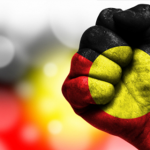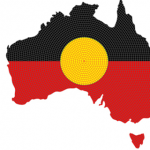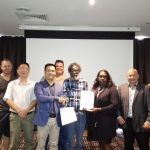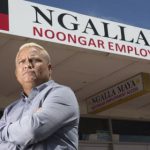Land Rights vs Native Title in NSW: An Interview With Professor Heidi Norman

The NSW Aboriginal Land Rights Council (NSWALC) was established in 1977 as an independent lobby group to assist in the fight for Indigenous land rights. It formed at a meeting of 200 First Nations representatives held at the Black Theatre in Redfern.
Over 1977 to 1981, the NSWALC submitted ten land claims with the NSW government. The land council called for community ownership of land based on traditional ownership rights, cultural heritage and direct control over the land Aboriginal communities occupied.
The demands of the NSWALC led to the establishment of a NSW parliamentary inquiry in 1978. And following the recommendations of the inquiry, the Wran government passed the Aboriginal Land Rights Act 1983 (NSW).
This legislation established a system of Local Aboriginal Land Councils, which are bodies that can acquire and hold title over land. These councils operate under the guidance of the NSWALC, which the Act formally constituted as a statutory body.
The NSW land rights laws not only provided Aboriginal communities with a path to acquire freehold title, but they were also an attempt to provide compensation for the violent dispossession of land. And today, many assert that this land claim system is the most substantial in the country.
A prior claim to land
In 1992, the High Court of Australia’s Mabo decision recognised that Aboriginal and Torres Strait Islander peoples have a prior claim to the land. This ruling overturned the legal fiction of terra nullius, which the British based their takeover of the continent upon.
The Mabo decision led the Keating government to pass the Native Title Act 1993 (Cth). This legislation established a process for making native title claims, which recognise and protect the rights and interests of traditional owners.
Although, native title laws have been watered down over time. The 1996 High Court Wik decision ruled native title can coexist with the rights of a pastoral lease. But, the court also found that when there is a conflict of interest, the leaseholder’s rights always prevail, and native title is extinguished.
The risk of conflict
Heidi Norman is a professor of social and political sciences at the UTS School of Communication. She’s pointed out that the two systems of Aboriginal land entitlement operating in this state are heading for a collision.
Professor Norman has warned that an escalation in land recovery settlements in NSW, under both land rights and native title claims, could see these two overlapping systems leading to intra-communal conflict.
The Gomeroi woman is the author of What Do We Want? A Political History of Aboriginal Land Rights in New South Wales. Published in 2015, it tracks the history of the establishment of land rights laws in this state and the governance of lands by Aboriginal citizens through land councils.
Sydney Criminal Lawyers® spoke to Professor Norman about why the system of land rights in this state is so robust, the differences between land rights and native title, and how a conflict between these two systems could be averted.
Firstly, the NSW Aboriginal Land Rights Act was passed in this state by the Wran government in 1983. You’ve described the system of land rights it established as the “most substantial land justice package in the country”.
Professor Norman, can you describe what it is about the system in this state that makes it so robust?
Starting in 1966, there were land transfers in South Australia. In 1970, there was the first of several pieces of legislation that saw the transfer of land in Victoria to Aboriginal control. In 1995, land was transferred in Tasmania to Aboriginal community control.
Thinking about that south eastern pocket, which is an area that shares similar patterns in the length, duration and scale of violence in terms of being dispossessed of land, in Victoria and Tasmania, they were land transfers, whereas what the Wran Labor government embarked upon was a reconsideration of what land meant in terms of a social justice package.
They created a mechanism for the recovery of land. A compensation fund – which no other land laws have – and a political structure that would in effect represent a kind of Aboriginal government that came in the form of Local Aboriginal Land Councils.
When I spoke with Frank Walker – who has since past away, he was the inaugural minister – he spoke about land councils as political cells.
There are 120 across NSW now. And how they operated varies. It’s fair to say they are the only representative bodies in NSW. And they are a space that interfaces with local government, the state government and to an extent, the federal government.
Because land was considered within a social justice package, it was disaggregated from the idea of proving traditional connection to country. The recovery of land is not linked to showing or demonstrating the significance of land.
And the NSW Aboriginal Land Council works as the local land councils’ representative body?
Yes. It was initially a three-tiered structure with a regional body. That was demolished by the Greiner Liberal government. When the Liberal government came into power, they were absolutely determined to eradicate land rights. They tried everything without success.
They were the first new right government. And they opposed land rights on the ground that it recognised a form of difference that was anathema to Liberal ideas.
Over the three and a half decades since the NSW land rights system has been in place, what has it resulted in for First Nations peoples in this state?
This is where we have to start to think carefully about some qualifications. One is that it’s less than a fraction of one percent of land that has been recovered under the Land Rights Act.
So, even though it was a very simple administrative process for recovering land, there have only been close to 3,000 land claims approved and there’s a long queue of just over 30,000 waiting for government action. One of those dates back to 1984.
Some senior public servants have referred to the land claims process as broken. If you are standing outside of government, you might be more actively pointing to government recalcitrance: a reluctance on the part of successive governments to actually step up and transfer Crown land.
Following the establishment of the land rights system in NSW, the Keating government passed the Native Title Act in 1993. How do native title rights differ from land rights?
In NSW, land rights laws had a political rationale that underpinned them. They were left-wing politicians who devised these laws, with the support of the Labor government. And they really thought about land rights as a social justice package and about power.
So, the creation of a network of power for Aboriginal people to regather and recover, with some financial support, with funding to create enterprises and the return of land. Land was an important part of land rights, but not the entire project.
At that time, within the minds of those politicians that drafted the land right laws, they didn’t comprehend the enduring and abiding claim to sovereignty.
They didn’t appreciate it wasn’t just any land and land as an economic base. It was about land and lore. It was about land and recognition of your occupation and connection to that land since forever.
That recognition wasn’t part of land rights. You don’t get that satisfaction of the Crown acknowledging that you have been on this country since prior to the arrival of the British and you have survived that.
That psychological factor and form of high recognition from the state of your occupation and place that’s the important difference between land rights and native title.
What underpinned land rights was the assumption that in effect the traditional ways of the Aboriginal people in the space of NSW and south eastern Australia had been lost. They were acknowledging the historical violence and how that had altered communities.
So, they were thinking about the reserves and missions and how these spaces had been reactivated in a way that aligns with traditional values.
That’s about creating a more contemporary form of Aboriginal belonging and connection to country, whereas native title says that your connection to place predates the arrival of the British and has survived since.
Since native title has come into play, how has it been applied in this state?
These two laws interface in different ways. There are a few things to take note of. One is that on land that is recovered under the Lands Rights Act native title continues. In any other circumstances of freehold land native title is extinguished, whereas for land councils native title lives on.
That backlog of more than 30,000 claims, in my calculation, 98 percent of them have been lodged since 1994, which means that once those land claims have eventually been dealt with the bulk of that land will be subject to native title.
And while native title has been high volume across northern Australia, we’ve only seen twelve beneficial determinations in NSW. And almost half of those have occurred in the last three years.
In between 40 and 50 percent of the state native title claims have been registered. So, you can see a collision course.
There has been some work in thinking about where the strength of both laws – native title and land rights – can be brought together to produce more beneficial outcomes.
One benefit, of course, is land covered under the Land Rights Act is freehold, whereas that’s rarely the case with native title claims. And the last few native title determinations involve native title claims over land held by land councils.
You’ve pointed out that there’s an increase in this state in both types of land recovery claims and you’ve warned that this could lead to intra-communal conflict.
Yes. The determination of native title is accelerating. In the Federal Court, they’ve made it clear that they won’t be allowing those native title claims to sit in the court for 18 to 20 years, as we’ve seen in the past. So, there is a speed up in those determinations.
At the same time, there will be an acceleration in the agreements with the outstanding land rights claims.
Both of these laws are seeing an acceleration of the recovery of land and the recognition of interests in land. And they both, in theory, construct different interests in land.
Is anything being done to address these concerns in NSW at present?
The state office of the land council and native title services have signed off on an agreement. The language the land council state office use is that they want to work with traditional owner groups, so that sentiment is in writing.
But, that may not have the same force at the local level. And it’s at the local level that contest plays out.
In one example, you can see where it’s land council land. Joint management of the land was negotiated between the land council and National Parks. And a register of owners was established to oversee the governance of that. And then there was a native title claim over the top of that, which introduces another layer of oversight through the traditional owner group.
In that case, one argument that the land council and native title services have run is that here is an example of the two Acts working together. A more critical view might be that this creates a complex layering in the management of a particular parcel of land.
And lastly, Professor Norman, what do you see as the way forward to this land rights/native title conflict of interest that’s arising in this state? And how would you recommend it’s resolved?
The two laws have enormous benefit. And elements of those combined can only be a good thing.
There’s another factor and that is the Crown Lands Act. So, the devolution of the management of Crown land to local government and to other interested parties who might like to play a part in the management of Crown land. That Crown land law has just come into effect in the last few months.
That sees land councils and other groups negotiating with their local government to potentially play a leading role in the management of land. And leaving aside the complex legal settings. I think that opens up a conversation about the role of Aboriginal groups – land councils or traditional owner groups – as managers of land.
The recovery of land, whether it’s through either of those laws, becomes quite complicated by bureaucracy.
But, there’s some possibility within this management and devolution of Crown land where we could see a reshuffling that fixes in the mind of the public, the important role and contribution Aboriginal people can make in managing and caring for land. So, that could be a bit of a circuit breaker.
Within that Crown Lands Act, there is the possibility of issuing a certificate that temporarily extinguishes native title. And a version of that could possibly be included in the Land Rights Act.
If you are a non-claimant – and that could be a land council – you have to go through the Federal Court and apply for a declaration to confirm the extinguishment of native title, where it exists on your land.
It’s very expensive. It costs tens of thousands of dollars. You have to spend somewhere between months and a year in the Federal Court seeking that determination. But, that’s necessary in order for land councils in any instance where they make a development application to do any work on their land.
So, that example of issuing a certificate under the Crown Land Act is something that could work under the Land Rights Act. But, that would be a job for clever lawyers.
There are options there to allow land councils to deal with their land estate where native title applies. At the moment, as we’ll see into the future, from a land council point of view, what land councils can do with their land in terms of development is highly constrained by the existence of native title.







